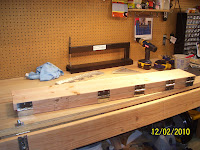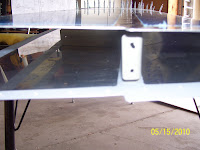So here I am again - seriously delinquent in posting my latest airplane building activities on the blog. Before I start ramping up on all that again, I wanted to take a moment to share a small remembrance of my second journey to EAA Airventure in Oshkosh, (or "SLOSHKOSH,"for reasons I will explain later) which just recently concluded.
The theme for this year's Airventure was A Salute to Veterans. Most of the activities on the grounds and during the daily airshows were geared toward honoring the service men and women and the military aircraft that have served our wonderful country for so many years now. The following is a story about something that happened to me up there that really made me reflect on the true meaning of this year's theme, and it has stuck with me ever since.
After arriving safely in Oshkosh and setting up the trailer for the week-long stay in Camp Scholler, I was experiencing some problems getting the car started, and ended up taking it into a shop that, fortunately for me, was only a couple of miles down the road. Long story short, they drove me back to the campground after I dropped the car off, and by the end of the day the car got a new battery and was ready to be picked up. The problem was that since it was the end of the day, noone was available to pick me up and take me back to the shop to pick up the car.
So I worked out an arrangement to walk to the shop from the campground and pick up the car. As I walked along the side of road, cars wizzing by me, I heard someone saying that it looked like I was in for a very long walk. I turned and saw an elderly gentleman dressed in a WWII Khaki uniform sitting in a chair next to an awning. Under the awning were several tables of WWII paraphernalia - helmets, M1 ammunition clips, dummy 20mm canon rounds, etc.
I stopped to look at the collection, and noticed that the signs that accompanied the display were promoting a WWII museum, which sat almost hidden from view of the road only 20 or 30 yards away. My first thought was that I was not even aware that this was out here - right next to the camp ground at Oshkosh. There was no advertisement, nor mention of this facilitity in any of the Airventure literature, and I found this quite odd, being that the theme for this year was supposed to be a salute to all veterans. In fact, this building and the car shop are the only other buildings on Poberezny road, on which I walking to pick up my car. If you were driving on the road you would miss this building since it sits just out of sight from the road.
I then continued to look at the items on the display table, and I noticed a back and white framed photo of a soldier in a tank crew uniform sitting on the gun of a German Tiger tank. The gentleman informed me that it was a picture of him in 1945, to which I asked, "So how is it that you came to sit on the gun of a perfectly healthy enemy tank?" He then told me that the war had just ended, and that if that had not been the case, the Germans might not have been very eager to allow him to sit on their tank. We both laughed as I acknowledged his response.
I then noticed another photo of Richard L. Bong and his wife Marge, sitting in the cockpit of his famed P-38 fighter. You have to understand that Dick Bong was one of the leading aces of the entire war in the pacific, and was also a Wisconsin Native. His aircraft also sits perfectly preserved at the EAA Museum, with Marge's picture painted clearly on the side, right next to the large number of Japanese flags that represent the number of aircraft he shot down. I had never seen this photo before, and as a devout WWII history buff, that is very unusual for me. The gentleman informed me that he had asked Marge if he could take the photo and blow it up larger than life for display in the Museum. She obliged him, and apparently he also came into possession of the original photo after Marge's passing just a couple of years ago.
I then mentioned to him that it was a shame that more people are not aware of this facility, while it sits in the shadow of all of the Airventure fanfair. I also told him I admired him for sitting in the hot sun to help promote the preservation of lessons and memories from what seems to be a long time ago now. He simply smiled, looked me in the eye, and replied "Well, that's OK, we are old and retired and have nothing better to do anyway."
He then offered me a drink of water, which I politely declined, thinking he most certainly needs it out here in the hot sun more than me. Then I shook his hand, and thanked him for his service to our country, and for sharing some of his history and memories with me. Then I wished him well with the museum and his efforts and continued on my way.
As I walked away something kept bugging me about what he said to me just moments earlier, that they were old and retired, and that he and his friends had nothing better to do anyway, and that people were too busy to remember all of those things that happened so long ago. It has been almost two weeks now and it has continued to bother me to the point where I felt that I just had to write this down. The thing that bothers me the most is that I failed to ask him his name, or to find out more about what unit he served with and where he served, because I was too busy trying to get my car back.
So, I guess the only thing I can do at this point is to make this blind statement in response to his comments, and hope that he and all of his brothers and sisters who sacrificed everything for which we should all be so eternally greatful will somehow hear and appreciate these words:
I will ALWAYS remember, and I will ALWAYS care about everything that was done by all those who have ensured the freedoms that I am able experience today - -freedom to build and fly my own airplane; freedom to live in a country free of tyranny and oppression; and freedom to share my experiences with those that I consider to be my friends, and to have them share their experiences with me - -even from those whose names I will never know, or that I have long since forgotten.
That is my personal Salute to Veterans, and a memory that I will cherish for the rest of my days. You just never know what will happen when you go to Oshkosh to experience Airventure!




 A much better "first run" working with the primer this time. The trick is definitely to mix the crap out of the primer and the reducer to ensure that it has the consistency of skim milk, so it will run off the end of my mixing stick for a second or two. You don't wait to start priming after mixing this stuff like you might do with epoxy-based primers. You just pour it in the cup and go.
A much better "first run" working with the primer this time. The trick is definitely to mix the crap out of the primer and the reducer to ensure that it has the consistency of skim milk, so it will run off the end of my mixing stick for a second or two. You don't wait to start priming after mixing this stuff like you might do with epoxy-based primers. You just pour it in the cup and go. 











































